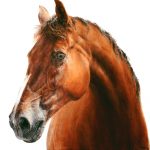 As the horizon rises to meet the sun slipping behind cloud into evening, I ascend the hill behind the house with my equine friend. The other two horses are already snacking on the soft straw covering the level section where we arrive. Looking down, the valley opens green and inviting before rising to the small white village perched on a hill at its extremity. In a time of faceless death, this is a soothing exit. Pip seems to be ready. Within minutes I am cradling the head of my dying mare, whispering reassurances to the friend I am wrenching away. The growing emptiness is vast and heavy. I choke on my tears. Enough self-indulgence. I bend my lips to Pip’s brow and thank her for all the joy that she has shared with me. How fortunate I am to know such pain for without it there could have been no joy.
As the horizon rises to meet the sun slipping behind cloud into evening, I ascend the hill behind the house with my equine friend. The other two horses are already snacking on the soft straw covering the level section where we arrive. Looking down, the valley opens green and inviting before rising to the small white village perched on a hill at its extremity. In a time of faceless death, this is a soothing exit. Pip seems to be ready. Within minutes I am cradling the head of my dying mare, whispering reassurances to the friend I am wrenching away. The growing emptiness is vast and heavy. I choke on my tears. Enough self-indulgence. I bend my lips to Pip’s brow and thank her for all the joy that she has shared with me. How fortunate I am to know such pain for without it there could have been no joy.
Pip and the Pain of Joy
May 16th, 2020 by Andrew
Do We Know the Physiological Horse?
May 8th, 2020 by Andrew
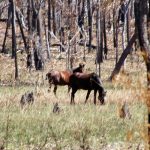 There is a tendency amongst some humans to romanticise the wild. Let us resist the temptation, for the wild can be a hard, uncompromising place. We may also want to bear in mind that the truly wild horse is extinct. All the horses that currently live in the wild are actually feral. This is to say that they or their ancestors used to live in captivity, if only briefly, as in the case of the Przewalski horses. This may appear to be a shortcoming, a detraction from what might otherwise have been a living historical record of horses that are truly wild. And perhaps it is.
There is a tendency amongst some humans to romanticise the wild. Let us resist the temptation, for the wild can be a hard, uncompromising place. We may also want to bear in mind that the truly wild horse is extinct. All the horses that currently live in the wild are actually feral. This is to say that they or their ancestors used to live in captivity, if only briefly, as in the case of the Przewalski horses. This may appear to be a shortcoming, a detraction from what might otherwise have been a living historical record of horses that are truly wild. And perhaps it is.
Tags: horses, humans, physiology
The Horse-Human Relationship: Control or Choice?
Apr 23rd, 2020 by Andrew
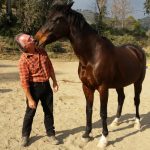 Around the world there is a growing tide of humans in search of a new way of being with horses, one that is in tune with their needs and requirements as equines and which also contributes to their psychological and emotional well-being. No longer are these humans prepared to accept conventional horsemanship’s insistence on horse care and training regimes which are utterly opposed to the horse’s intrinsic nature as a fellow sentient and cognitive being, and a highly sensitive and sociable one at that. As far as possible these humans seek to keep their horses in conditions which are in line with their understanding of the nature of the horse. Continue Reading »
Around the world there is a growing tide of humans in search of a new way of being with horses, one that is in tune with their needs and requirements as equines and which also contributes to their psychological and emotional well-being. No longer are these humans prepared to accept conventional horsemanship’s insistence on horse care and training regimes which are utterly opposed to the horse’s intrinsic nature as a fellow sentient and cognitive being, and a highly sensitive and sociable one at that. As far as possible these humans seek to keep their horses in conditions which are in line with their understanding of the nature of the horse. Continue Reading »
Being Human(s) for Horses
Apr 5th, 2020 by Andrew
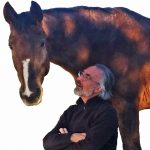 After several years of writing and reflection, I have just finished the first draft of Being Human(s) for Horses. This is the book that I was meant to write about horses. The others are simply meaningful milestones along the way. If all goes according to plan, it will be published in the northern hemisphere summer.
After several years of writing and reflection, I have just finished the first draft of Being Human(s) for Horses. This is the book that I was meant to write about horses. The others are simply meaningful milestones along the way. If all goes according to plan, it will be published in the northern hemisphere summer.
Tags: Being Human(s) for Horses, horses, humans, Pip
Equine Bodywork and the Challenge of Choice
Feb 19th, 2020 by Andrew
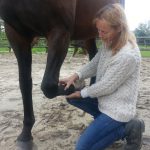 So what could happen if a horse encounters pain in the course of an equine bodywork session in which you are the practitioner and the horse is not restrained in any way whatsoever, meaning they have a choice? What is the horse likely to do? Stay or walk away? What would you be more inclined to do or refrain from doing? And perhaps more importantly, why would you even consider an equine bodywork session without any restraint on a horse with whom you have only conducted two previous sessions, during which they have clearly shown that they are experiencing pain while restrained with a halter and a lead rope held by another experienced bodywork practitioner? Why present the horse and yourself with the challenge of choice?
So what could happen if a horse encounters pain in the course of an equine bodywork session in which you are the practitioner and the horse is not restrained in any way whatsoever, meaning they have a choice? What is the horse likely to do? Stay or walk away? What would you be more inclined to do or refrain from doing? And perhaps more importantly, why would you even consider an equine bodywork session without any restraint on a horse with whom you have only conducted two previous sessions, during which they have clearly shown that they are experiencing pain while restrained with a halter and a lead rope held by another experienced bodywork practitioner? Why present the horse and yourself with the challenge of choice?
Tags: Anaïs, Equine Touch, Farinelli, Gulliver, horses, humans, Pip


